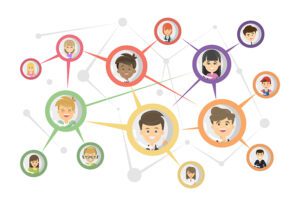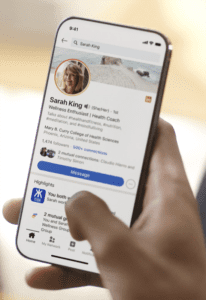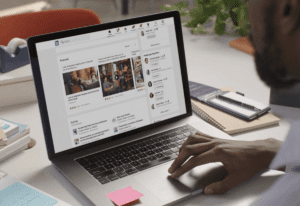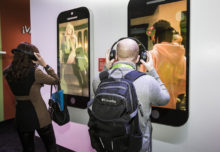Communications experts share best networking practices for yourself—and your attendees
 Live experiences may be back, but when it comes to the social and interpersonal aspects of the job, many industry professionals find themselves in a state of transition. Some are returning to large-scale in-person events for the first time in three years. Others are meeting new remote colleagues or visiting with prospective clients. Attendees who once complained of digital fatigue are happily still working remotely, and as such, are expecting to gain a lot of value—and networking time—from the in-person experiences they travel to. It’s an adjustment period for all, whether you’re a restless extrovert or a misunderstood introvert.
Live experiences may be back, but when it comes to the social and interpersonal aspects of the job, many industry professionals find themselves in a state of transition. Some are returning to large-scale in-person events for the first time in three years. Others are meeting new remote colleagues or visiting with prospective clients. Attendees who once complained of digital fatigue are happily still working remotely, and as such, are expecting to gain a lot of value—and networking time—from the in-person experiences they travel to. It’s an adjustment period for all, whether you’re a restless extrovert or a misunderstood introvert.
To alleviate some of the post-pandemic social anxiety you may be experiencing, we turned to three experts for some best practices on making strategic and successful connections across in-person and online spaces. They also offered insights on where networking stands in today’s climate.
 More Post-pandemic Industry Updates:
More Post-pandemic Industry Updates:
- From Staffing to Shipping, Event Leaders Share Their Perspectives on Recent Industry Pain Points
- Four Brands Weigh in on What it Really Means to ‘Add Value’ to Events
EASE BACK INTO IT
It’s important to be gentle and honest with yourself as you transition back into live events, says Don Colliver, a member of Toastmasters, a nonprofit that promotes communication, public speaking and leadership skills, and a facilitator and communication consultant with over 20 years of experience consulting for companies like Google, Cisco, Adobe and GM.
“I talk a lot in my courses about personal and social competence. Personal competence means being self-aware of how am I feeling right now? Am I feeling really overstimulated?” Colliver says. “Trade shows are the perfect place to inadvertently get yourself over-exhausted because you just stay out—going out with clients, talking all day and then going out to dinner. Don’t push yourself out of your comfort zone.”
Besides the wide range of comfort and risk levels related to the pandemic, personality types play a role in how relaxed or apprehensive someone may be in returning to social interactions.
Dorie Clark, executive education professor at Duke University’s Fuqua School of Business and author of “The Long Game: How to be a Long-term Thinker in a Short-term World,” considers herself an introvert. Clark says people often don’t believe her because she gives lectures and keynote speeches in front of large audiences, but certain social situations can make her feel uncomfortable, like being in a room full of people she doesn’t know or, worse, when all the attendees seem to know each other, leaving Clark as the odd one out.
“I think what we often forget is that even prior to COVID, it’s not like networking was a comfortable activity for everyone. There were plenty of people who did not thrive under the way that networking events were typically organized, and I think the shift to virtual gave people more permission to acknowledge and name that,” she says. “The way events have traditionally been structured has been incredibly biased to extroverts, but now we’re recognizing that there may be better ways to reconfigure things to make them more inclusive for everyone.”
KEEP IT SIMPLE
 To improve the attendee experience, particularly for introverts, Clark offers two solutions. The first is to share information in advance about who will be attending the event so attendees unfamiliar with the group of participants can do some research and prepare ahead of meeting in person. A second solution Clark points to is having comically large name tags with huge font, which she once came across at an event.
To improve the attendee experience, particularly for introverts, Clark offers two solutions. The first is to share information in advance about who will be attending the event so attendees unfamiliar with the group of participants can do some research and prepare ahead of meeting in person. A second solution Clark points to is having comically large name tags with huge font, which she once came across at an event.
“We’re human; we’re going to meet someone and forget their name. It’s going to be embarrassing, and then, under normal circumstances, you’re peering down looking for their name tag,” she says. “But with this ginormous thing, it says, ‘Dorie,’ and everybody’s like, ‘Oh, hi, Dorie!’ It’s such a simple thing that just reinforces the name and makes it easier and more comfortable.”
On overcoming the anxieties of meeting new people, Colliver suggests taking small steps and starting with a local meetup hosted by a professional association or organization.
“Look for a small-scale, low-stakes networking event where you can go practice and don’t have to stick around for more than 30 or 45 minutes, and maybe set a goal of getting three business cards, rather than jumping into the marathon of a Vegas trade show for five days,” he says.
MASTERING SMALL TALK
When making small talk, the weather is usually the first topic that comes to mind, but Clark isn’t a fan of mundane weather discussions because they don’t offer any insight on the person you’re speaking to. She instead recommends keeping a few situational-based stock questions in your back pocket as conversation starters.
“Something that is almost universally helpful and relevant is, ‘Is this your first time at the conference or event?’ because that can lead you down a useful path,” Clark says. “Another one is, ‘What are you working on right now?’ It gives you a window into what they do, and, presumably, if you’re asking what they’re excited about, it’s something that will animate them in some way and make it, hopefully, a positive conversational experience.”
Citing psychologist and professor Robert Cialdini, who specializes in the science of influence, Clark says the first thing you should do when meeting someone is establish some kind of commonality, which can create enough rapport to delve deeper into getting to know one another and potentially develop a working relationship in the future.
Colliver says authenticity is vital—“be yourself and be present in the moment”—something he learned in his time as a Blue Man and a theatrical clown for Spiegelworld that he now incorporates into his training courses and is part of his book, “Wink: Transforming Public Speaking with Clown Presence.”
“There’s an art for the whole elevator pitch idea, understanding how to communicate what it is you do and love in a very succinct and compelling way that doesn’t feel forced,” he says. “That’s especially for networking where everybody goes around asking, ‘What do you do?’ And there are some people who nail it and some who don’t. I think it’s a matter of forethought and preparation to develop a perfect way of communicating your passion and what you do.”
“There’s an art for the whole elevator pitch idea, understanding how to communicate what it is you do and love in a very succinct and compelling way that doesn’t feel forced.”
–Don Colliver, communication consultant
THE LINKEDIN FACTOR
One tool bridging the gap between in-person and online connections is LinkedIn. Speaker and author Donna Serdula has always believed that LinkedIn is “a place where you can network in your pajamas,” and that sentiment rang true during the pandemic, especially at the onset of the Great Resignation.
“It really took a new role, and people turned to it in a time when they needed connection that they weren’t getting at the water cooler or in the office,” says Serdula, founder and president of Vision Board Media and LinkedIn-Makeover.com. “LinkedIn was always there and available to stay connected, but I don’t think it ever had the push that it did during the pandemic. It’s a place where you can not only set your brand through a profile, but you can get active and engage with others through the newsfeed.”
Since 2009, Serdula has been helping professionals embrace LinkedIn to establish a personal brand and understand the power of its features and reach through her SOAR methodology: strategize, optimize, amplify and relate.
 “Before you can even begin to optimize your profile, you need to have an understanding of your goal, your story and the keywords that your target audience might be using to find someone like you,” she says. “LinkedIn isn’t just for job search; it could be for reputation management, executive branding, sales prospecting, competitive intelligence or professional development. It’s important to say, ‘I want to be on LinkedIn because… I want to control how people perceive me, I want to own my brand or I want to be in control of my career.’”
“Before you can even begin to optimize your profile, you need to have an understanding of your goal, your story and the keywords that your target audience might be using to find someone like you,” she says. “LinkedIn isn’t just for job search; it could be for reputation management, executive branding, sales prospecting, competitive intelligence or professional development. It’s important to say, ‘I want to be on LinkedIn because… I want to control how people perceive me, I want to own my brand or I want to be in control of my career.’”
Serdula recognizes that most people struggle to write about themselves, but it’s not something that can be put off because opportunities and connections can slip away. It all starts with telling your story in a warm and engaging manner, using the right keywords geared toward a defined audience. (See sidebar on pg. 20 for Serdula’s tips on optimizing a LinkedIn profile.)
Once a profile is optimized, it’s time to grow your LinkedIn network. One way to start is by connecting with people you’ve worked with IRL. Your online network should reflect your offline network, Serdula says. Then, you can expand to thought leaders and companies you admire, but there’s a difference between following and connecting on LinkedIn: “You follow people you don’t know; you connect with people you do,” Serdula explains.
Following industry hashtags like #events, #tradeshows, #activations and #eventmarketing can bring pertinent news and thought leaders into your newsfeed. The key to success on LinkedIn is engaging with content, liking, commenting and sharing posts, which essentially upvotes the message, Serdula says, but posting your own content is the ultimate goal. She recommends posting high-quality content once a week consistently and spending the rest of the week interacting with the newsfeed.
“How do you pivot to the real world? You call people, send a message, ask them to do a Zoom or meet for a cup of coffee,” Serdula says. “People are hungry for human connection. They need it, and you just have to be that person who offers it. You’ll be surprised by the response.”
FOUR STEPS TO OPTIMIZE YOUR LINKEDIN PROFILE
 Donna Serdula, author of “LinkedIn Profile Optimization for Dummies,” offers tips to craft a profile that reflects who you are as an event marketer or agency professional, your career journey and aspirations for the future.
Donna Serdula, author of “LinkedIn Profile Optimization for Dummies,” offers tips to craft a profile that reflects who you are as an event marketer or agency professional, your career journey and aspirations for the future.
Think about your target audience. Who are they? What do they need to know about you? What would make you a perfect fit for an available opportunity?
Choose the right keywords. LinkedIn is a database of professionals for professionals, Serdula says, so incorporating keywords into a profile in an organic and contextualized manner can attract those on the hunt for specific talent or services. “If those words aren’t in your profile, you’re not going to pop up in those searches,” she says.
Upload a professional profile picture. Serdula emphasizes that the photo should be a high-resolution headshot cropped in close on a smiling face. While it’s best for profile pictures to be professionally taken, if a photographer isn’t available, ask someone to take your photo rather than using a selfie. Also, select a background banner graphic that illustrates who you are and what you do.
Showcase work samples, articles, links and media in the Featured section. Examples and imagery help construct a professional narrative.
Photo credit: LinkedIn; iStock
This story appeared in the Spring 2023 issue






